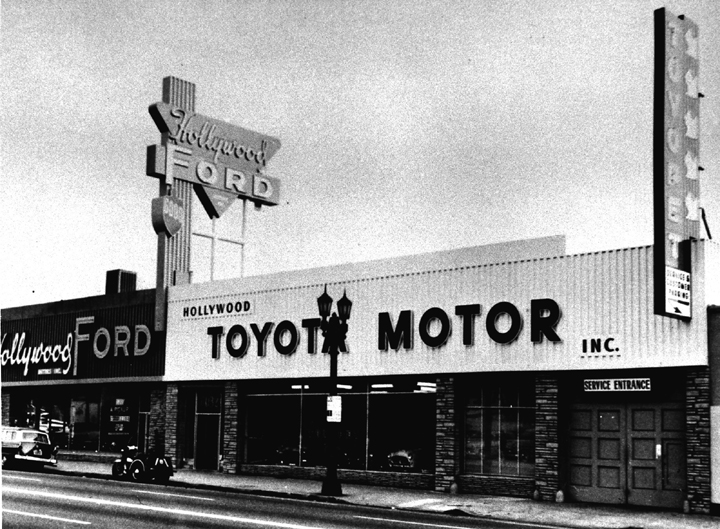Section 9. Preparations for Mass Production and Mass Sales
Item 5. Toyota's Entry into the United States
Passenger car exports suspended
To counter the increase in sales of imported compact cars, American automakers launched several compact cars from the autumn of 1959, including the Chevrolet Corvair, Ford Falcon, and Chrysler Valiant. As a result, sales of imported European cars plunged, and most dealers that sold both American cars and the Crown switched from the Crown to these compact cars. In response, exports of the Crown to the United States were suspended in December 1960.
Meanwhile, exports of the new Corona with the R engine-sold as the Tiara (Model RT20L)-began in June 1960. Like the Crown, however, the Tiara suffered from a lack of output at high speeds, vibration and noise caused by insufficient rigidity of the body, insufficient strength in the suspension, inadequate brake durability, and other quality-related problems. Exports to the United States had to be slowed down.
Toyota Motor Sales, U.S.A. increased its capital to two million dollars and took measures to reinforce its financial standing in 1960, but accumulated losses at the end of the year exceeded 1.42 million dollars and were expected to grow even further. Even with financial support from Japan, restrictions under the Foreign Exchange and Foreign Trade Act did not easily allow for increases in capital to make up for losses. Consequently, Toyota Motor Sales, U.S.A. was required to make harsh improvements in management.
The main points of the improvement measures were as follows.
- 1)Limit sales to the Land Cruiser for the time being and passenger car sales were temporarily suspended until the development of a car suitable for the U.S. market.
- 2)Establish management structures such that the company could be profitable with monthly Land Cruiser sales of 50 to 60 units.
Based on these basic policies, Toyota Motor Sales, U.S.A. cut personnel, reduced business sites, and slashed expenses in 1961. The workforce was cut from 57 to 37, and employees seconded from Japan were reduced to a bare minimum. The head office was relocated to the building of a directly-managed dealer to reduce expenses.
In addition to the effects from these management improvements, sales of the Land Cruiser increased, and the company made a profit in 1961. As a result, a capital increase of 500,000 dollars was approved in 1962, and a 250,000 dollar capital increase was implemented. Also, with the shift in the focus of sales to the Land Cruiser, Toyota Motor Sales, U.S.A.'s sales of the Land Cruiser increased by more than 10-fold over four years, jumping from 249 units in 1961 to 2,595 units in 1964. In order to implement these management improvements, Toyota Motor Sales, U.S.A. officers Sadazo Yamamoto and Seishi Kato-who also served as managing director and senior managing officer of Toyota Motor Sales Co., Ltd. respectively-directly managed local operations. In addition, Toyota Motor Co., Ltd. Executive Vice President Eiji Toyoda went to America to confirm local management conditions in detail, learn first-hand information concerning the specifications of the U.S.-compliant vehicles, and encourage their development.
As Japan entered the era of the highway, the Model RT40 third-generation Corona series was launched in September 1964 and sold well. The new Model RT43L Corona with a 3R engine (1,897 cc, 90 hp/5,000 rpm) was developed specifically for the U.S. market and sample shipments began in April 1965. At the end of that year, the eagerly-awaited model with an automatic transmission was added to the lineup, contributing substantially to the increase in sales in the United States.
After studying at Ford in the United States in 1950, Managing Director Eiji conducted research and development of automatic transmissions with an eye towards easier driving and exports to the United States in the future. The first practical application of an automatic transmission in Japan was on the Masterline commercial vehicle in 1959. In the U.S. imported vehicle market, it was the Corona that acted as the pioneer. The percentage of automatic transmissions on the Corona in 1965 was just 12 percent, but increased to more than 50 percent in the next and following years.
After an establishment with inadequate preparation and eight years of difficulty, Toyota Motor Sales, U.S.A. finally had the new Corona, a vehicle suitable for the U.S. market, and grabbed the opportunity for success. The number of dealers rapidly increased from 200 in late 1964 to 384 in 1965 and 606 in 1966, and the time for reorganization of the sales network arrived.


